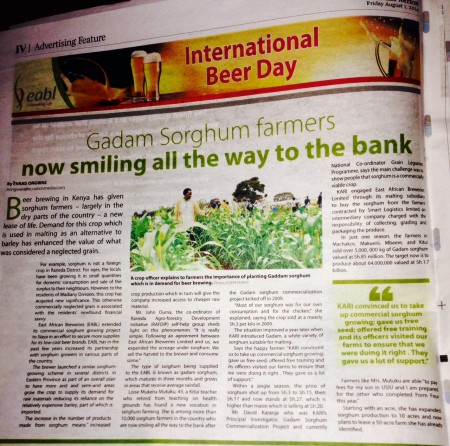- Population structure and diversity in cultivated and wild Luffa species. Luffa hermaphrodita is the closest wild species.
- Factors Enhancing Landrace in Situ Conservation in Home Gardens and Fields in Vall de Gósol, Catalan Pyrenees, Iberian Peninsula. It’s not just about landrace performance.
- Sorghum Genetic Resources: Conservation and Diversity Assessment for Enhanced Utilization in Sorghum Improvement. 236,000 accessions, 38,000 at ICRISAT alone, of which 3 have proved useful. Wait, what?
- Genetic Diversity in Eucalypts. It’s high, and needs to be used.
- Explaining the decrease in the genetic diversity of wheat in France over the 20th century. Because breeding.
- Animal-breeding schemes using genomic information need breeding plans designed to maximise long-term genetic gains. You can’t just wing it.
- Remaining natural vegetation in the global biodiversity hotspots. 15%, and fragmented.
- Targeting Global Protected Area Expansion for Imperiled Biodiversity. Increasing protected area coverage to Aichi targets would do little to achieve threatened species coverage in situ, at least for vertebrates.
- Phenotypic evaluation and characterization of a collection of Malus species. German apple collection characterized the old school way, and none the worse for that.
Gadam sorghum in the limelight
Remember the Gadam variety, saviour of Kenya’s sorghum farmers? Well, I came across it again a couple of days ago, on the occasion of International Beer Day 1, as part of an advertizing feature in the Kenya’s Nation newspaper.
Talk about mainstream.
Wheat everywhere
Wheat has been much in the news in the past few days. There’s been the announcement of the draft genome sequence. And some fancy gene editing from China. But I want to point to a couple of more down-stream stories.
From Spain, there’s news of how an old variety — and much effort from a local family — brought back the particular taste of Los Monegros’ bread. Should anyone else be interested, the variety in question, Aragon 03, seems to be available in various genebanks.
And, from an area that is even more inhospitable to the crop, comes an announcement by Nigeria’s minister of agriculture himself that a new variety may turn the country into a major producer:
#Nigeria to be a major wheat producer with new tropical wheat that gives 6 tons per hectare. It will change the north pic.twitter.com/QRDQw9jdrP
— Akinwumi A. Adesina (@akin_adesina) July 27, 2014
Intrigued, I investigated further, and found that the variety in question, called Norman Borlaug in Nigeria, is Norman F2008, which was released by a private company a few years back in Mexico, based on CIMMYT material.
We’re going to need heat resistant wheat like this.
Bringing ancient farming to life
There are pigs, sheep and goats here. Some are ancient varieties, more popular 1,400 years ago than they are today. Like a shaggy-haired pig described my guide, John Sadler, as “half a ton of very grumpy animal … only interested if you feed it, or if you fall in — in which case you are food.”
That’s from a podcast I follow, The World in Words, which is about languages, not agricultural biodiversity. This particular episode was part of a series about places which have been important in the evolution of the English language, and focuses on Jarrow in northern England, haunt of the Venerable Bede.
“He’s the first person to actually write down who it was that actually came to the British Isles,” says linguist David Crystal, co-author with Hilary Crystal of Wordsmiths and Warriors. “He talks about the Angles and the Saxons and the Jutes, and discusses the range of languages that were spoken around the country.”
The grumpy pig and other animals “are part of a re-creation of an Anglo-Saxon village, with timber-framed buildings and turf-covered sheds. The farm is called Gyrwe, Old English for Jarrow. It’s part of a museum called Bedesworld.”
Its website has a little bit on the livestock you can see there, but I couldn’t find anything on any crops that might be part of the experience, which is a pity. I hadn’t thought much about this before, but such open-air museums focusing on the history of farming could be useful ways of communicating the importance of conserving agricultural biodiversity, and indeed even doing some conservation. There are many of them, in the US, in Europe (see also) and elsewhere. And there are some journals that cater to them.
Does anyone out there know of examples of farming museums such as Bede’s World doing serious conservation of crop diversity?
Surviving Glenda
We have finally received news of the Philippines national genebank. Teresita Borromeo, who has worked there for some years, sent us the following email:
Yes, after 8 years, we were again devastated by the typhoon. The storage room is fortunately safe but our regeneration areas were completely damaged as well as our field gene bank. There was not much flood water as in 2006 but the winds were strong which lasted around ten hours. We had electricity just last Friday afternoon, so our freezers were first powered by generator. This again highlights the need for safety duplication within and outside the country. UPLB is greatly damaged, many trees fell down.
Seconded.
